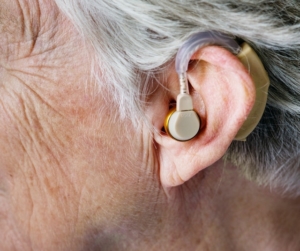Hearing aids can improve your elderly parent’s quality of life
Hearing aids can improve your elderly parent’s quality of life
 According to an article published on SeniorLiving.org, 31 million people in the United States develop hearing loss of some severity or another. Nearly 60 percent of those with hearing loss are over age 65. More than 6 million Americans use hearing aids, but that leaves 24 million who do not. If you suspect your elderly parent is experiencing hearing loss, having them get a hearing aid will improve their quality of life as well as make your life easier.
According to an article published on SeniorLiving.org, 31 million people in the United States develop hearing loss of some severity or another. Nearly 60 percent of those with hearing loss are over age 65. More than 6 million Americans use hearing aids, but that leaves 24 million who do not. If you suspect your elderly parent is experiencing hearing loss, having them get a hearing aid will improve their quality of life as well as make your life easier.
Fitting a hearing aid is easy with an open-fit digital hearing aid. In the past, an audiologist would make a silicon mold of your ear for a custom fit. Todays open-fit and speaker-in-the-ear models require no molds and only minor tweaks for a custom fit.
Most performance adjustments used to require a visit to an audiologists office where adjustments would be made and you’d be on your way. But adjusting in an office for real world hearing loss was rarely perfect. Although still common today, oftentimes you’d have to make another trip back for a readjustment. Now, using computer software, you can program your hearing aid from home. With some software, you can type a problem like Conversations are muffled. Then the software automatically adjusts the hearing aid for you. Other times, the hearing aid vendor can make the adjustments and email you the adjustment file.
The Mayo Clinic goes in-depth about the differences between various hearing aids. Here is some of their information summarized:
Completely in the canal — These hearing aids are molded to individual ear canals to improve mild to moderate hearing loss. Generally, the smaller a hearing aid is, the less powerful it is, the shorter its battery life and the more it’ll cost. These are least noticeable in the ear, and less likely to pick up wind noise. They are easy to use with phones and use smaller batteries that don’t typically last as long. These hearing aids often don’t contain added features like volume control or directional microphones.
In the canal — Like in completely in the canal hearing aids, these are custom molded to fit in the ear canal, but not as deeply. These improve mild to moderate hearing loss in adults. In the canal hearing aids are less visible, easy to use with the phone, but also include features that won’t fit on completely in the canal aids. However, the small size can make these features difficult to adjust and they may not fit well in smaller ears.
Half-shell — An even smaller version of the in the canal hearing aid. These are custom molded and fill the lower portion of the bowl-shaped area of the outer ear. This will counteract mild to moderately severe hearing loss. This hearing aid is slightly easier to handle than smaller hearing aids. It includes additional features like directional microphones and volume control.
In the ear (full-shell) — An in-the-ear (full-shell) hearing will be custom made to fill most of the bowl-shaped area of the outer ear. It is useful for those with mild to severe hearing loss. This model will be more visible to others and may pick up wind noise. It does contain helpful features like volume control and the features are easier to adjust. These are typically easy to insert and use larger batteries which normally last longer than their smaller counterparts.
Behind the ear — Behind-the-ear hearing aids hook over the top of your ear and rest behind the ear. They pick up sound, amplify it and carry the sound back to an ear mold that fits inside your ear canal. This is useful for all types of hearing loss. It is also the largest, most visible type of hearing aid, though newer versions may be smaller and barely visible.
Open fit — These are usually a very small behind-the-ear-style device. Sound travels from the instrument through a small tube to a tiny dome or speaker in the ear canal. These leave the ear canal open and are best for mild to moderate high-frequency loss where low frequencies are still heard near normal. These often lack manual adjustments because of the small size.
Physicians Choice Private Duty currently serving Omaha, Eastern Nebraska and Western Iowa provides seniors and their families a complete understanding of the available care options and helps families maneuver through the challenges of the system. All Physicians Choice Private Duty services are directed by registered nurses or social workers with no long-term contracts. Contact us today for help with your senior care needs.
“Physicians Choice Private Duty solves the problems families face in finding home health care providers they can trust. Providers who will focus on strategies that keep parents in their homes. To learn more about our health care services, visit https://private-duty.pchhc.com/services/“


